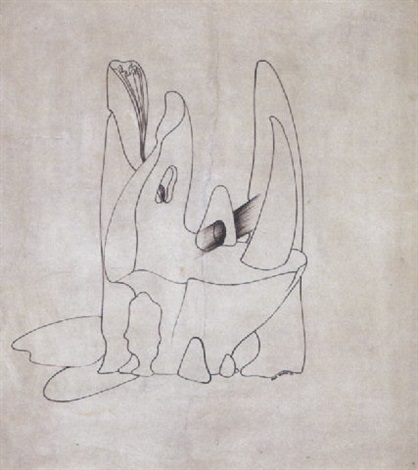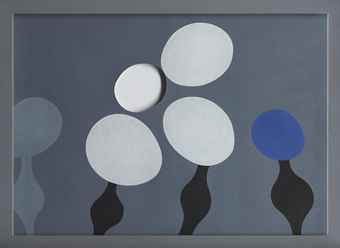Christie’s will present a stellar selection of 36 lots in the much anticipated annual evening sale of The Art of The Surreal on 4 February 2015. The auction comprises works from many important collections, led by Joan Miró’s masterful L'oiseau au plumage déployé vole vers l'arbre argenté, 1953, from a Distinguished European Collection (estimate: £7-9 million, illustrated above left). Tailored to meet the market’s ever growing appetite for surrealist works, further highlights include notable examples by Magritte, Chagall, Picabia, Arp, Ernst, Tanguy and Dominguez. Christie’s overall evening of Impressionist, Modern and Surrealist Art on 4 February has a total pre-sale estimate of £92.8 million to £133.8 million.
MIRÓ
|
A diverse group of works by Joan Miró points to the breadth of
techniques and media that the artist worked in, from oil on canvas and
oil on burlap to gouache on black paper. The artist’s key themes and
subjects ranged from poetry and dreams to music and stars, women
and birds; he was an artist who allowed himself to be influenced by a
range of things, from music, poetry and hallucinations induced by
hunger during his early years in Paris, to patterns made by chance. The
group is led by the most valuable of the Modern and Surrealist works
from the collection,
Miró’s masterful L'oiseau au plumage déployé vole vers l'arbre argenté, 1953, which is a remarkable example of his artistic developments in the early 1950s (estimate: £7-9 million). Covering a large canvas, the painting combines a wealth of effects, pairing precise, graphic details with expressive effusions of paint. Evoking a fantastical world, populated by curious creatures, L’Oiseau au plumage déployé vole vers l’arbre argenté combines the poetry of its title with Miró’s enticing visual universe. This work was once part of the celebrated American collection of Edgar Kaufmann Jr.
Two further works by Miró are Untitled (Image), 1937, a large gouache on black paper (estimate: £1-1.5 million) and
L'échelle de l'évasion (The Escape Ladder), 1939, oil on burlap, which is one of two pivotal works with this title which he executed at this significant period in his career (estimate: £3-5 million, illustrated right); this is one of the very last of nine paintings Miró executed on burlap, known as the Varengeville II series. L'Echelle de l’évasion is among the most colourful and densely worked pictures in this series and is a work that led him directly to the famous ‘Constellations’ series.
Miró’s masterful L'oiseau au plumage déployé vole vers l'arbre argenté, 1953, which is a remarkable example of his artistic developments in the early 1950s (estimate: £7-9 million). Covering a large canvas, the painting combines a wealth of effects, pairing precise, graphic details with expressive effusions of paint. Evoking a fantastical world, populated by curious creatures, L’Oiseau au plumage déployé vole vers l’arbre argenté combines the poetry of its title with Miró’s enticing visual universe. This work was once part of the celebrated American collection of Edgar Kaufmann Jr.
Two further works by Miró are Untitled (Image), 1937, a large gouache on black paper (estimate: £1-1.5 million) and
L'échelle de l'évasion (The Escape Ladder), 1939, oil on burlap, which is one of two pivotal works with this title which he executed at this significant period in his career (estimate: £3-5 million, illustrated right); this is one of the very last of nine paintings Miró executed on burlap, known as the Varengeville II series. L'Echelle de l’évasion is among the most colourful and densely worked pictures in this series and is a work that led him directly to the famous ‘Constellations’ series.
MAGRITTE
|
A total of 9 works by René Magritte are presented in the sale, 8 of which are from the Distinguished European Collection which comprises 4 oils on canvas and 4 gouaches on paper. This season’s offering by the artist spans Magritte’s oeuvre and includes much of his most iconic imagery, together constituting the most extraordinary and extensive group of works by Magritte to come to the market since the landmark Harry Torczyner sale in 1998, which took place at Christie’s New York and established new market price levels for the artist. Leading the group is
Les compagnons de la peur, a triumphantly eerie work from 1942 which centres on the subject of transformation, challenging the realms of possibility and turning the traditions of landscape and portraiture painting on their head, to present – perched atop a mountain - four owls transforming from bird to plant world, or vice-versa (estimate: £2.7-3.5 million).
Magritte’s highly poetic gouache Le thérapeute, 1962, subverts the nature of pictures and the concept of the portrait with the captivating absence at the heart of the composition: the torso of the subject is a void through which the blue sky and clouds of a summer’s day entices the viewer beyond the twinkling night sky (estimate: £600,000-900,000, ).
Les compagnons de la peur, a triumphantly eerie work from 1942 which centres on the subject of transformation, challenging the realms of possibility and turning the traditions of landscape and portraiture painting on their head, to present – perched atop a mountain - four owls transforming from bird to plant world, or vice-versa (estimate: £2.7-3.5 million).
Magritte’s highly poetic gouache Le thérapeute, 1962, subverts the nature of pictures and the concept of the portrait with the captivating absence at the heart of the composition: the torso of the subject is a void through which the blue sky and clouds of a summer’s day entices the viewer beyond the twinkling night sky (estimate: £600,000-900,000, ).
A beautifully composed painting that dates to a period of great happiness and stability for Marc Chagall, Jeune fille au cheval, 1927-1929, is offered at auction for the first time, having been acquired by A Private European Family almost 60 years ago (estimate: £2.2-2.8 million, illustrated right). A mirage of surreal and magical lyricism and blissful romance which encompasses Chagall’s favoured themes of love, memory, music and fantasy, Jeune fille au cheval exemplifies the artist’s unique and deeply personal artistic vision. Executed in iridescent, delicate colours and soft brushstrokes, it depicts a woman adorned in flowers sitting atop a horse emerging from a misty blue haze, while an airborne violinist plays across from her, with a rural street scene from Chagall’s beloved hometown, Vitebsk, beyond. Chagall’s works from this period have a soothing, gentle atmosphere. Filled with flowers, lovers or fiddlers, they all exude a poetic harmony. In Jeune fille au cheval the components of the composition are unified through the delicate light, rich colours, and tender, romantic mood. The rich blue, dreamlike haze from which the image emerges could have developed from Chagall’s fascination with the French landscape, particularly the Côte d’Azur, which the artist had visited for the first time in 1926, three years before Jeune fille au cheval was painted. The gentle glow of light lends the painting a pictorial cohesion and compositional unity while evoking the fantastical, imaginary context.
Mid-Lent (Mi-Carême), painted in 1925, by Francis Picabia is one of the very few works from the artist’s important ‘Monsters’ series to remain in private hands (estimate: £1-1.5 million. It has been requested for inclusion in an exhibition at The Museum of Modern Art, New York, June 2016 to April 2017. In the winter of 1924-5 Picabia began a series of paintings that deliberately ridiculed the rich socialites who celebrated carnival in Cannes during the winter season. Executed in the cheap brand of household enamel paint known as Ripolin, these paintings, famously dubbed by his friend and colleague Marcel Duchamp as the ‘Monsters’, were based on scenes from the masked balls of Cannes which were especially decadent and lavish at this time. The present canvas is one of the finest of this anti-art, anti-modernist and anti-classical series of paintings that epitomise Picabia’s unique and fiercely individualistic stance towards both life and art. His deliberately iconoclastic approach to painting and the carnival-like gaudiness of his technique were part of a radical and ground-breaking anti-modernist aesthetic that, though revolutionary and shocking in the 1920s, was to have a significant influence on many post-modernist approaches to painting in the 1970s and ‘80s, particularly upon the work of Sigmar Polke. Similarly, Picabia’s adoption of Ripolin and the free-flowing liberty this paint lent his work not only influenced Picasso, who used Ripolin from 1925 through to the end of his life, but can also can be seen to anticipate Jackson Pollock’s similar free-form use of the medium in the 1940s.
Balcon I (Balcony I), 1925, by Jean (Hans) Arp is the first of two extremely rare and unique reliefs that each depict a strange sperm/egg-like universe of abstract form (estimate: £900,000-1.2 million, illustrated right). The present work, which is offered from a European Private Collection, is painted on a board that has been cut-out or perforated with an oval aperture so that this seemingly flat work becomes a multi-dimensional relief. Both Balcon I and Balcon II eloquently articulate the marriage of nature and abstraction that Arp developed in the mid-1920s into an essentially poetic and almost mystic form of construction. Arp’s reliefs of the 1920s signify one of the most dramatic stylistic changes in his art. Having understood the ‘law’ of chance during the Dada years in Zurich to be but a part of the laws of Nature he began to revere it as an ultimate standard of spiritual truth. As a consequence, he made a conscious move away from the harsh, rigid logic of his geometric abstraction and sought to infuse the forms of his art with Nature’s rhythm, energy and spirit. Arp’s involvement with the Surrealists played a significant role in the development of this new organic abstraction. While he insisted on remaining only loosely affiliated to the group, later criticising its overt embracing of politics and their rejection of abstract art, the Surrealists use of poetry as a means of exploring the unconscious had a major influence on Arp, who likened his work to dreams.
(Price Realized £1,497,250 Christie's 2012)
ERNST
|
Offered for the first time in over half a century from A Private European Collection and unseen in public since it was exhibited in London at The Tate’s From Cézanne to Picasso: The Moltzau Collection, October - November 1958, Don Juan et Faustroll, 1951, by Max Ernst is a large and important painting (estimate: £500,000-800,000, illustrated left ). It was exhibited at the Venice Biennale in 1954 where Ernst was awarded the highest honour: the Grand Prix for painting, providing the long-overdue international recognition he had always sought. Executed shortly after returning to Arizona from his first visit to Europe since fleeing the Fascist Occupation in 1940, it is rich in detail and painterly techniques. This painting draws on both the Native American–derived style of his years in Sedona, Arizona and also anticipates the more mystical astronomy and alchemy-infused work that would characterise his ‘Maximiliana’ years after his eventual return to Europe in 1954.
***************
Overall, the sale presents surrealist works by a total of 15 artists, including

an exquisite painting byYves Tanguy from 1935, Composition surréaliste, depicting strange rock-like forms or personages stretching out across the painting like a strip of calligraphy (estimate: £450,000-550,000, ; and Madamme, 1937, by Oscar Domínguez, which dates from the artist’s partisan years within Surrealism, when he contributed extensively to the movement and produced some of his most significant works (estimate: £400,000-600,000). The other artists featured are: Salvador Dalí, Paul Delvaux, Alberto Giacometti, André Masson, Matta, Odilon Redon and Antoni Tàpies.

an exquisite painting byYves Tanguy from 1935, Composition surréaliste, depicting strange rock-like forms or personages stretching out across the painting like a strip of calligraphy (estimate: £450,000-550,000, ; and Madamme, 1937, by Oscar Domínguez, which dates from the artist’s partisan years within Surrealism, when he contributed extensively to the movement and produced some of his most significant works (estimate: £400,000-600,000). The other artists featured are: Salvador Dalí, Paul Delvaux, Alberto Giacometti, André Masson, Matta, Odilon Redon and Antoni Tàpies.





